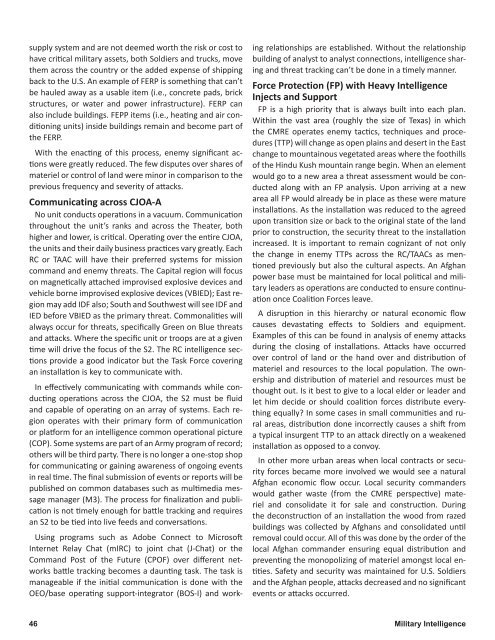incorrect
2015_02
2015_02
- No tags were found...
You also want an ePaper? Increase the reach of your titles
YUMPU automatically turns print PDFs into web optimized ePapers that Google loves.
supply system and are not deemed worth the risk or cost to<br />
have critical military assets, both Soldiers and trucks, move<br />
them across the country or the added expense of shipping<br />
back to the U.S. An example of FERP is something that can’t<br />
be hauled away as a usable item (i.e., concrete pads, brick<br />
structures, or water and power infrastructure). FERP can<br />
also include buildings. FEPP items (i.e., heating and air conditioning<br />
units) inside buildings remain and become part of<br />
the FERP.<br />
With the enacting of this process, enemy significant actions<br />
were greatly reduced. The few disputes over shares of<br />
materiel or control of land were minor in comparison to the<br />
previous frequency and severity of attacks.<br />
Communicating across CJOA-A<br />
No unit conducts operations in a vacuum. Communication<br />
throughout the unit’s ranks and across the Theater, both<br />
higher and lower, is critical. Operating over the entire CJOA,<br />
the units and their daily business practices vary greatly. Each<br />
RC or TAAC will have their preferred systems for mission<br />
command and enemy threats. The Capital region will focus<br />
on magnetically attached improvised explosive devices and<br />
vehicle borne improvised explosive devices (VBIED); East region<br />
may add IDF also; South and Southwest will see IDF and<br />
IED before VBIED as the primary threat. Commonalities will<br />
always occur for threats, specifically Green on Blue threats<br />
and attacks. Where the specific unit or troops are at a given<br />
time will drive the focus of the S2. The RC intelligence sections<br />
provide a good indicator but the Task Force covering<br />
an installation is key to communicate with.<br />
In effectively communicating with commands while conducting<br />
operations across the CJOA, the S2 must be fluid<br />
and capable of operating on an array of systems. Each region<br />
operates with their primary form of communication<br />
or platform for an intelligence common operational picture<br />
(COP). Some systems are part of an Army program of record;<br />
others will be third party. There is no longer a one-stop shop<br />
for communicating or gaining awareness of ongoing events<br />
in real time. The final submission of events or reports will be<br />
published on common databases such as multimedia message<br />
manager (M3). The process for finalization and publication<br />
is not timely enough for battle tracking and requires<br />
an S2 to be tied into live feeds and conversations.<br />
Using programs such as Adobe Connect to Microsoft<br />
Internet Relay Chat (mIRC) to joint chat (J-Chat) or the<br />
Command Post of the Future (CPOF) over different networks<br />
battle tracking becomes a daunting task. The task is<br />
manageable if the initial communication is done with the<br />
OEO/base operating support-integrator (BOS-I) and working<br />
relationships are established. Without the relationship<br />
building of analyst to analyst connections, intelligence sharing<br />
and threat tracking can’t be done in a timely manner.<br />
Force Protection (FP) with Heavy Intelligence<br />
Injects and Support<br />
FP is a high priority that is always built into each plan.<br />
Within the vast area (roughly the size of Texas) in which<br />
the CMRE operates enemy tactics, techniques and procedures<br />
(TTP) will change as open plains and desert in the East<br />
change to mountainous vegetated areas where the foothills<br />
of the Hindu Kush mountain range begin. When an element<br />
would go to a new area a threat assessment would be conducted<br />
along with an FP analysis. Upon arriving at a new<br />
area all FP would already be in place as these were mature<br />
installations. As the installation was reduced to the agreed<br />
upon transition size or back to the original state of the land<br />
prior to construction, the security threat to the installation<br />
increased. It is important to remain cognizant of not only<br />
the change in enemy TTPs across the RC/TAACs as mentioned<br />
previously but also the cultural aspects. An Afghan<br />
power base must be maintained for local political and military<br />
leaders as operations are conducted to ensure continuation<br />
once Coalition Forces leave.<br />
A disruption in this hierarchy or natural economic flow<br />
causes devastating effects to Soldiers and equipment.<br />
Examples of this can be found in analysis of enemy attacks<br />
during the closing of installations. Attacks have occurred<br />
over control of land or the hand over and distribution of<br />
materiel and resources to the local population. The ownership<br />
and distribution of materiel and resources must be<br />
thought out. Is it best to give to a local elder or leader and<br />
let him decide or should coalition forces distribute everything<br />
equally? In some cases in small communities and rural<br />
areas, distribution done <strong>incorrect</strong>ly causes a shift from<br />
a typical insurgent TTP to an attack directly on a weakened<br />
installation as opposed to a convoy.<br />
In other more urban areas when local contracts or security<br />
forces became more involved we would see a natural<br />
Afghan economic flow occur. Local security commanders<br />
would gather waste (from the CMRE perspective) materiel<br />
and consolidate it for sale and construction. During<br />
the deconstruction of an installation the wood from razed<br />
buildings was collected by Afghans and consolidated until<br />
removal could occur. All of this was done by the order of the<br />
local Afghan commander ensuring equal distribution and<br />
preventing the monopolizing of materiel amongst local entities.<br />
Safety and security was maintained for U.S. Soldiers<br />
and the Afghan people, attacks decreased and no significant<br />
events or attacks occurred.<br />
46 Military Intelligence


